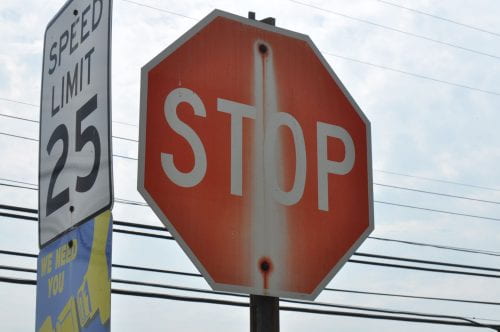 Okay, that’s a somewhat pretentious headline, but let’s look past it for the moment.
Okay, that’s a somewhat pretentious headline, but let’s look past it for the moment.
If your signs and pavement markings are in full compliance with the Delaware Manual on Uniform Traffic Control Devices (MUTCD)…seriously, wow! For the rest of us mortals, there’s work to do. But, a deliberate approach over time, with a plan, can mean progressive improvement towards the goal. Let’s map out a sensible approach that reflects the reality of a local agency’s funding, work force, and priorities.
The Delaware MUTCD provides the requirements for all traffic control devices for all streets open to public travel. It is not optional – it is codified in Delaware law. Therefore, local agencies should endeavor with all due haste to bring their network of signs and pavement markings into compliance. Why? Well, first, it’s the law. Next, it is part of how you better ensure that drivers, pedestrians, and cyclists on your roads can navigate safely. Third, federal funding for road projects can be contingent upon MUTCD compliance. Finally, there are potential legal ramifications if you do not. Lawsuits associated with crashes involving road users, particularly where injury results, can involve your agency if plaintiff’s attorneys can point to MUTCD non-compliance. And, devices intended to protect the public (think about Stop signs, Speed Limit signs, Yield to Pedestrian signs, crosswalk markings, and so on) are unenforceable if they are not compliant with the MUTCD (Section 1A.07), pursuant to the Delaware Code.
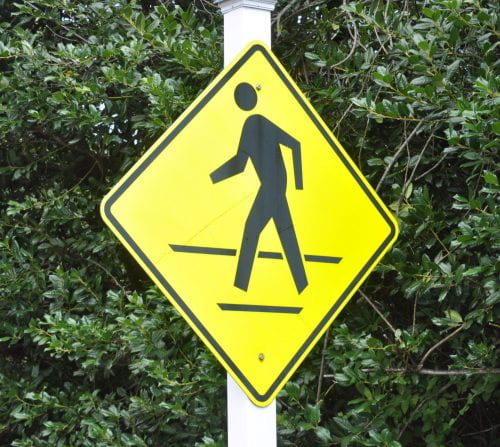 If you are like most local agencies, you have some traffic control devices (TCD) that are in great shape, some that are considerably out of compliance, and many that are partially compliant. Your network did not fall out of compliance overnight. Indeed, some of those non-compliant TCDs are a function of changes in the MUTCD over time. So, your plan to bring the system into compliance should be a multi-year plan as a practical matter. In other words, all due haste is a relative term. But, inaction is a problem that can cause you a problem at some point.
If you are like most local agencies, you have some traffic control devices (TCD) that are in great shape, some that are considerably out of compliance, and many that are partially compliant. Your network did not fall out of compliance overnight. Indeed, some of those non-compliant TCDs are a function of changes in the MUTCD over time. So, your plan to bring the system into compliance should be a multi-year plan as a practical matter. In other words, all due haste is a relative term. But, inaction is a problem that can cause you a problem at some point.
Priorities will vary by local agency. Here we will focus on municipal and city environments and for some that will mean a healthy mix of pedestrian, bicycle, and vehicular traffic. For others, pedestrian traffic may be more limited to a central business district or park area. Hence, one size does not fit all when it comes to priorities. But, for most, there will be some obvious priorities – areas of the city or town like the business district or around the libraries and playgrounds and certain devices like Stop signs and crosswalk markings.
A great place to start is to look for TCDs that aren’t necessary. Did you know that not every intersection requires a Stop sign? In fact, the right-of-way rules in the Delaware Code do not presume a need for intersection controls and Section 2B.04 of the MUTCD provides for engineering judgement to determine if a Stop or even a Yield condition is needed. Indeed, an overuse of Stop signs can lead to poor driver behavior. Guidance in the MUTCD includes vehicular, bicycle, and pedestrian traffic volumes, stopping sight distances, approach speeds, skewed intersections, and crash history. When Stop or Yield conditions are established, the secondary or less important street should be controlled first and the primary road can be triggered by such conditions as limited sight distances. But to be clear, Stop signs have been shown by research as counterproductive as a reactionary measure against speeding; in fact, poor driver behavior can result when they are over-used.
Similarly, are all of those Speed Limit signs really informing anyone of anything? Did you know that the Delaware Code has established the statutory speed limit in business and residential districts at 25 mph, and 20 mph at all school zones where 20 mph regulatory signs are posted that state the times or conditions during which the speed limit is in effect? So, yes, in school districts, regulatory signs are required for compliance, but otherwise, a licensed driver already knows that the speed limit in business and residential districts is 25 mph. You are cynically laughing, but it’s true – see the Delaware Driver Manual. And if you wish to post a different speed limit, Section 2B.13 of the MUTCD and the Delaware Code require an engineering study, so to be enforceable, you will need that in your file (the Delaware T2/LTAP Center can help you with that).
More generally, traffic control device should meet five basic requirements if they are to be effective:
- Fulfill a need;
- Command attention;
- Convey a clear, simple meaning;
- Command respect from road users; and
- Give adequate time for proper response.
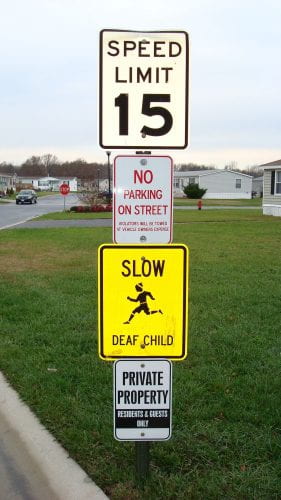 Take inventory of the signs and pavement markings in your network and you will likely find some that aren’t needed, are not modern devices that road users quickly recognize, are in the wrong place, or simply don’t tell the user what they should do differently. Some specific examples on that later. It is a great idea to put together a physical mapped inventory of your signs and even pavement markings, and it need not be expensive. It’s great to map it out in a geographical information system (GIS) but you can also just mark up a map of your jurisdiction and you can take inventory with your own forces during downtime (hold your laughter) or bring in temporary help such as interns to do it.
Take inventory of the signs and pavement markings in your network and you will likely find some that aren’t needed, are not modern devices that road users quickly recognize, are in the wrong place, or simply don’t tell the user what they should do differently. Some specific examples on that later. It is a great idea to put together a physical mapped inventory of your signs and even pavement markings, and it need not be expensive. It’s great to map it out in a geographical information system (GIS) but you can also just mark up a map of your jurisdiction and you can take inventory with your own forces during downtime (hold your laughter) or bring in temporary help such as interns to do it.
Once you have an inventory of all your devices, you will know better what you are up against; you know, instead of guessing. Then you can begin attacking them in waves, with your highest priorities in the first year or so and working through them. Perhaps you will bring all your Stop and various pedestrian signs, along with your crosswalk markings and Stop bars, into compliance in the first year or two. If you have a lot of them, maybe that is a three-year plan. After that, perhaps you will turn your focus to Speed Limit signs (if you need any) or travel lane markings. Maybe the next wave is parking signs and so on. If the plan will take 5-10 years, and it likely will, remember that some TCDs will need maintenance or replacement in that time. For example, good sign sheeting will lose its retroreflectivity in the range of 10-15 years, thermoplastic crosswalks may only last three years or so, and latex travel lane markings typically need replacement every couple of years, particularly if there is substantial snow plowing.
When replacing signs, it is time to start thinking more comprehensively. Don’t just replace that sign. Look at the supplemental signs or plaques to see if they are near the end of their useful life or a different sign is now required and consider replacing them also. Look at the post itself and ask yourself if it is in the right location, if it is offset properly, is the sign mounted high enough, and is the post crashworthy. We will take each of these one at a time so you know better how to make your decisions, but read the referenced areas of the Delaware MUTCD to understand it better.
- Is the sign actually necessary? Maybe it once was, but now is the time to be brutal about it. If it is not, that’s one less sign to maintain one less sign to clutter the aesthetics, one less sign to be vandalized, and one less sign to be crashed into (how ironic is that?). If it isn’t fulfilling a need or it doesn’t command respect and tell the road user what to do, consider removal.
- Is it the right sign? Do not put up the same sign that was there before consulting the appropriate section of the MUTCD. For example, all those 2-Way, 3-Way, and 4-Way plaques under Stop signs – do not replace them. Only All Way plaques are acceptable now (Section 2B.05). If it not an all way stop condition, one of the W4-4 series supplemental plaques is the new way to inform the road user what to expect and look for (Section 2C.59). You will be surprised how many signs have changed, so take the time to have a look.
- Is it the right size? Sizes have changed for a number of signs also. For example, the Yield to Pedestrians (R1-5) that you take down is probably 18”x18” but the new requirement is 36”x36” – yeah, it’s four times as large. That one will make you think about placement, which is our next topic.
- A sign, such as the Do Not Enter sign, can be mounted on the back of a Stop or Yield sign, but it should stay within the edges of the Stop or Yield sign. However, the size of the sign on the back should not be reduced below the required minimum; rather, the Stop or Yield sign should be increased in size to ensure its shape is not obscured.
- Is it in the right and best location?
- Section 2A.16 tells us signs should be located on the right-hand side of the road; there are times (close buildings, sight distance problems, etc.) where it cannot be, but you should have a good reason if it is on the left.
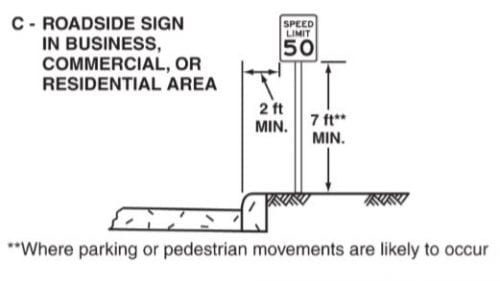
- Signs should not be clustered on a single post unless they go together (e.g., Stop and All Way). The collage shown below the Speed Limit sign (above) do not go together…and that’s just one thing that makes that picture a bad example.
- Section 2A.18 talks about mounting height (which is always a minimum of 5’), and signs in business, commercial, or residential areas where parking or pedestrian movements are likely to occur, or where the view of the sign might be obstructed, shall be 7 feet, measured vertically from the bottom of the sign to the top of the curb, or in the absence of curb, to the elevation of the near edge of the traveled way. A 7’ clearance from the sidewalk to the bottom of the sign is also required. If a secondary sign (e.g., All Way) is mounted below the primary sign such that the bottom of the secondary sign is less than 7’, it cannot project more than 4” into the pedestrian facility. For example, the No Outlet sign is not mounted high enough. You should replace any posts that are not of sufficient height as you replace signs.
- Trucks and cars that use the shoulders can strike signs or posts, so signs should be laterally offset 6’-12’ from the edge of the travel way to the nearest edge of the sign (i.e., not the post); Section 2A.19. This is sometimes impractical in commercial, business, and even residential areas, so a lateral offset of
 2’ to the leading edge of the sign is permitted and an offset of at least 1 foot from the face of the curb may be used in business, commercial or residential areas where the sidewalk width is limited or where existing poles are close to the curb. This final item should be a last resort and you shouldn’t get clever with the “lean method” to achieve it.
2’ to the leading edge of the sign is permitted and an offset of at least 1 foot from the face of the curb may be used in business, commercial or residential areas where the sidewalk width is limited or where existing poles are close to the curb. This final item should be a last resort and you shouldn’t get clever with the “lean method” to achieve it. - Next, you need to look at the post, because Section 2A.19 says that post-mounted sign supports shall be crashworthy (breakaway, yielding, or shielded with a longitudinal barrier or crash cushion) if within the clear zone (a recovery distance from the travel way for errant vehicles). A vertical curb is insufficient to stop many errant vehicles, so you should assume that your signs are mounted in the clear zone and they must be crashworthy.
- This gets complicated because it is difficult to know if your post is crashworthy. Some telltale signs that it is not:
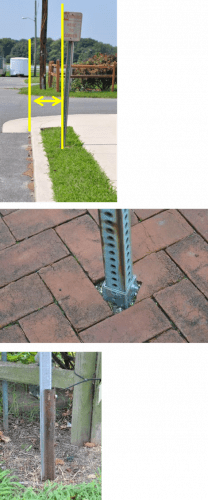
- It is a U-shaped post weighing more than 3 pounds per foot.
- It is any post that has a splice more than 4” off the ground.
- A helpful discussion on crashworthy posts can be found in the Federal Highway Administration’s Maintenance of Signs and Sign Supports; A Guide for Local Highway and Street Maintenance Personnel.
- As you travel around this topic, you will see reference to NCHRP Report 350 and the newer AASHTO Manual for Assessing Safety Hardware (MASH), which is based on different tests and test vehicles. Devices like sign posts have to survive MASH crash tests to be considered crashworthy, but ground-mounted sign support posts are lagging in the testing.
- 4”x4” wood posts are considered breakaway supports, but if a 6”x8” post is used, it must be drilled at 4” and 18” above grade with 3” diameter holes perpendicular to traffic.
- You should replace any posts that have any type of splice greater than 4” off the ground.

- Your best bet, until MASH testing of sign supports advances, is to use the Delaware Department of Transportation’s current standard detail (above), which can be found in their Standard Construction Details (Detail T-15 under Traffic).
- This gets complicated because it is difficult to know if your post is crashworthy. Some telltale signs that it is not:
- Make sure the sign will be visible to traffic at sufficient distance that they can see it, understand it, and have time to act accordingly. In particular, make sure that trees, shrubs, and other signs do not obstruct the sight distance and perform regular maintenance of vegetation to ensure they can be seen (Section 2A.22).
- Section 2A.16 tells us signs should be located on the right-hand side of the road; there are times (close buildings, sight distance problems, etc.) where it cannot be, but you should have a good reason if it is on the left.
Signs need to be replaced when they are damaged, vandalized, or otherwise impacted. Signs that are dirty or algae-covered can sometimes be cleaned but you should be careful that you don’t damage the retroreflective sheeting.
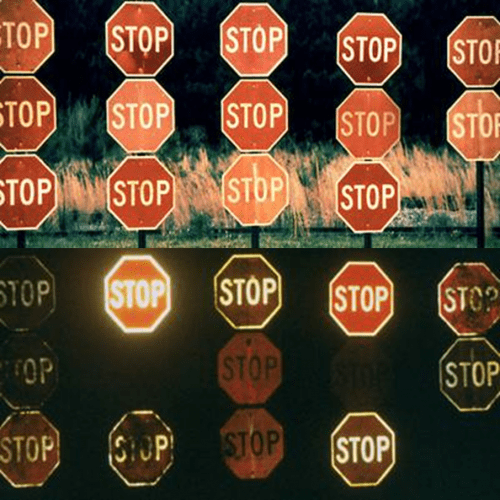 Minimum levels of retroreflectivity must be maintained within an assessment or management method (Sections 2A.07 and 2A.08) in accordance with Table 2A-3. If you wonder why, consider the daytime and nighttime look at the sign stand and notice that many of the Stop signs look fine
Minimum levels of retroreflectivity must be maintained within an assessment or management method (Sections 2A.07 and 2A.08) in accordance with Table 2A-3. If you wonder why, consider the daytime and nighttime look at the sign stand and notice that many of the Stop signs look fine  during the daylight, but disappear altogether at night. The prescribed methods include nighttime inspections (it is impossible to visually determine retroreflectivity otherwise), use of a retroreflectometer, or through blanket replacement or expected sign life. To be compliant, you must adopt one of these methods or a mix of them. The Delaware T2/LTAP Center can assist you with this and we also have a retroreflectometer that can be used if that route is chosen.
during the daylight, but disappear altogether at night. The prescribed methods include nighttime inspections (it is impossible to visually determine retroreflectivity otherwise), use of a retroreflectometer, or through blanket replacement or expected sign life. To be compliant, you must adopt one of these methods or a mix of them. The Delaware T2/LTAP Center can assist you with this and we also have a retroreflectometer that can be used if that route is chosen.
When replacing Stop signs, take careful note of the size requirements in Section 2B.03. A minimum size of 36”x36” inches should be used for Stop signs at intersections that include one or more state-maintained roadway(s) and where a road intersects a multi-lane road, although Stop signs at the intersection of two subdivision streets should be 30”x30”. The larger 36”x36” Stop sign can be very impactful in business, commercial, and residential environments. Stop signs smaller than 30”x30” are not permitted (and therefore, unenforceable), except in the rare instances described in Section 2A.11 where for alleys with restrictive physical conditions and vehicle usage that limits installation of the Minimum size sign (or the Conventional Road size sign if no Minimum size is shown), both the sign height and the sign width may be decreased by up to 6 inches.
Another common urban signage need is for pedestrians. First, based on current Delaware Code, the Yield Here to Pedestrians sign should be used (not Stop). The R1-5 sign is installed when Yield markings are installed on the pavement, 20-50 feet in advance of the crosswalk and parking should be prohibited between  the Yield line and the crosswalk (Section 2B.11). The R1-6 in-street pedestrian sign, if used, shall be installed (on a crashworthy mount) at the centerline of the crosswalk location and it should be fixed to the pavement (DelDOT Traffic must approve installations in DelDOT maintained streets); Section 2B.12.
the Yield line and the crosswalk (Section 2B.11). The R1-6 in-street pedestrian sign, if used, shall be installed (on a crashworthy mount) at the centerline of the crosswalk location and it should be fixed to the pavement (DelDOT Traffic must approve installations in DelDOT maintained streets); Section 2B.12.
 The W11-2 sign may be used to alert road users in advance of locations where unexpected entries into the roadway might occur or where shared use of the roadway by pedestrians, animals, or equestrians might occur (e.g., they should not be over-used). If the W11-2 sign is used at the location of the crossing point, the diagonal downward pointing arrow (W16-7P) plaque shall be mounted below it. If the W11-2 sign is placed in advance of a crossing, it should be supplemented with AHEAD or XX FEET plaques to inform road users that they are approaching a point where crossing activity might occur; this is sometimes used to denote repeated pedestrian crossings for a period of space. These signs may be used with a fluorescent yellow-green background for emphasis, although mixing of standard yellow and fluorescent yellow-green backgrounds should be avoided (Section 2C.50). This is a highly condensed treatment of the requirements and guidance for pedestrian signs and pavement markings and the relevant sections should be carefully studied to develop an effective pedestrian warning system.
The W11-2 sign may be used to alert road users in advance of locations where unexpected entries into the roadway might occur or where shared use of the roadway by pedestrians, animals, or equestrians might occur (e.g., they should not be over-used). If the W11-2 sign is used at the location of the crossing point, the diagonal downward pointing arrow (W16-7P) plaque shall be mounted below it. If the W11-2 sign is placed in advance of a crossing, it should be supplemented with AHEAD or XX FEET plaques to inform road users that they are approaching a point where crossing activity might occur; this is sometimes used to denote repeated pedestrian crossings for a period of space. These signs may be used with a fluorescent yellow-green background for emphasis, although mixing of standard yellow and fluorescent yellow-green backgrounds should be avoided (Section 2C.50). This is a highly condensed treatment of the requirements and guidance for pedestrian signs and pavement markings and the relevant sections should be carefully studied to develop an effective pedestrian warning system.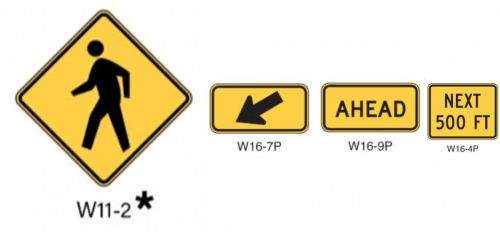
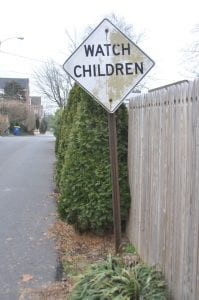 Earlier, we discussed signs that are of questionable value (indeed, research shows some can be ineffective or counterproductive). Often, signs such as the Watch Children at left are erected (despite protest) as a reactionary message where the real issues, such as speeding, are frustrating the community. Signs like this or Children at Play can imply that the street is appropriate as a playground; it is not. Worse, signs like this are often allowed to degrade, as has this one, further diminishing its ability to command respect.
Earlier, we discussed signs that are of questionable value (indeed, research shows some can be ineffective or counterproductive). Often, signs such as the Watch Children at left are erected (despite protest) as a reactionary message where the real issues, such as speeding, are frustrating the community. Signs like this or Children at Play can imply that the street is appropriate as a playground; it is not. Worse, signs like this are often allowed to degrade, as has this one, further diminishing its ability to command respect.
Certainly, even compliant signs should be used with care. For example, if you have a modern Watch Children (W21-11-DE) sign on one residential street, but not the next one, what are you telling the driver to do differently? Do they not need to watch for children on the next street? Warning signs like 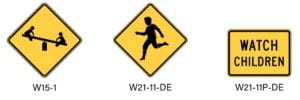 these are intended to alert road users in advance of locations where unexpected entries into the roadway might occur or where shared use of the roadway by pedestrians or animals might occur. The Watch Children (W21-11P-DE) plaque should be mounted below another warning sign. The Playground (W15-1) sign may be used to give advance warning of a designated children’s playground that is located adjacent to the road (Section 2B.50 and 51). It should be noted that signs such as Children at Play are not part of the Delaware MUTCD.
these are intended to alert road users in advance of locations where unexpected entries into the roadway might occur or where shared use of the roadway by pedestrians or animals might occur. The Watch Children (W21-11P-DE) plaque should be mounted below another warning sign. The Playground (W15-1) sign may be used to give advance warning of a designated children’s playground that is located adjacent to the road (Section 2B.50 and 51). It should be noted that signs such as Children at Play are not part of the Delaware MUTCD.
If you take care of all the items we have discussed above, you have graduated and you will be in need of something more than just the Survivor’s Guide. But for many of you, the topics herein can be a large undertaking over several years all by themselves. The Delaware T2/LTAP Center’s Municipal Engineering Circuit Rider is intended to provide technical assistance and training to local agencies and so if you have MUTCD questions or other transportation issues, contact Matt Carter at matheu@udel.edu or (302) 831-7236.

You must be logged in to post a comment.